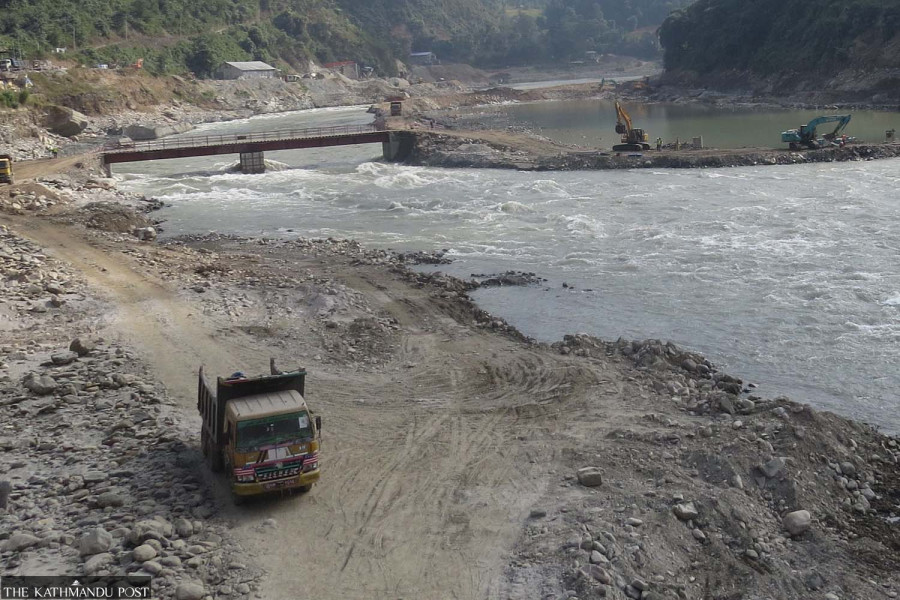Money
Dam construction for 100MW Super Trishuli project begins
The largest private-sector funding will build a 24.5-metre-tall dam on the Trishuli river. Unlike other hydel projects, no tunnel will be needed to divert water.
Ramesh Kumar Paudel
The work on constructing a 24.5-metre-high dam for the 100MW Super Trishuli Hydropower Project on the Trishuli river, the largest private sector undertaking, has started.
This is also the first run-of-river project in Nepal that will not require a tunnel.
The powerhouse will be built at the bottom of the dam in the Trishuli basin. The plant consists of three turbines, two each with 33.33 MW output and one with the 33.4MW optimum capacity.
Project developer Blue Energy is said to have started diverting water to build the dam between Butar of Gandaki Municipality, Gorkha, and Chumlingtar of Ichhakamana Municipality, Chitwan.
The four-year project started in March 2023.
Blue Energy said this would be the first project in Nepal that will need no tunnel to channel dam water as the powerhouse in Butar of Gorkha will be close by.
“Around 20 percent of work was completed before Dashain. The work is making satisfactory progress,” said Niranjan Regmi, director of Blue Energy.
The total investment is Rs16 billion. As construction is going on in a major river, floods in the rainy season can obstruct work.
In the monsoon gone by, Regmi said, massive flooding swept away machinery, transport vehicles, and construction materials. He said the company faced around Rs200 million in damages, particularly in the late September floods.
Five barrages will be constructed to discharge the water, said Dibya Raj Panta, the project's geologist. Each barrage is 12-metre high and 5-metre-wide.
Normally, the Trishuli river’s flow is 600 cubic metres per second. At the past monsoon’s end, the water flow was measured at 5,000 cusec.
The dam has been designed to withstand a maximum flow of 9,800 cusec.
Fish ladders will be constructed in one of the five dams to mitigate the impact on the fish populations. The specialised structures are designed to facilitate fish movement through the barriers, allowing them uninterrupted migration routes.
After the dam is built, a lake will be formed in Phisling, Chitwan, extending 3.5 km upstream.
The electricity produced is proposed to be connected to the national grid in Marki Chowk of Abu Khaireni, Tanahun, 18 km from the project site. “If the transmission line is constructed in the nearby areas before the project's completion, it will be connected to it,” said Panta.
The company obtained the survey licence in 2009.
Before the earthquake in 2015, a Chinese company was appointed the project contractor. However, due to Covid-19, the work was stalled.
The project for civil and hydromechanical works was awarded to CE Construction Pvt Ltd. The deal involves planning, design, engineering and construction. Electro-mechanical works are being done by GE Power India Ltd.
Except for the dam, all the project structures are on the Gorkha side at Butar.
The project, however, has courted controversy.
Himalayan Gorkha Outdoor Resort Private Limited, which is close to the project, has claimed that it incurred losses of Rs50 million in the September flood due to the project. The resort is currently closed.
There was a rock hill 200 metres from the resort. “The project removed it, triggering a current to the resort, which caused the damage,” said Mahendra Singh Thapa, the resort's director. He has demanded compensation from the project.
“The shutdown of the resort will cause us losses of Rs5 million annually,” said Thapa.
Blue Energy officials have denied responsibility for the losses. “The rainfall was unexpected, and the flood was massive. We, too, suffered damages worth millions,” he said.




 6.12°C Kathmandu
6.12°C Kathmandu1.jpg)















